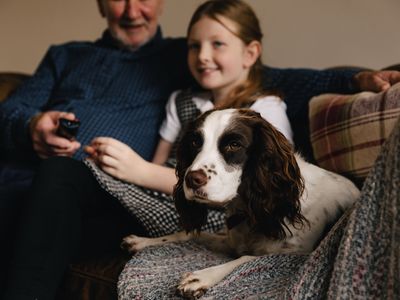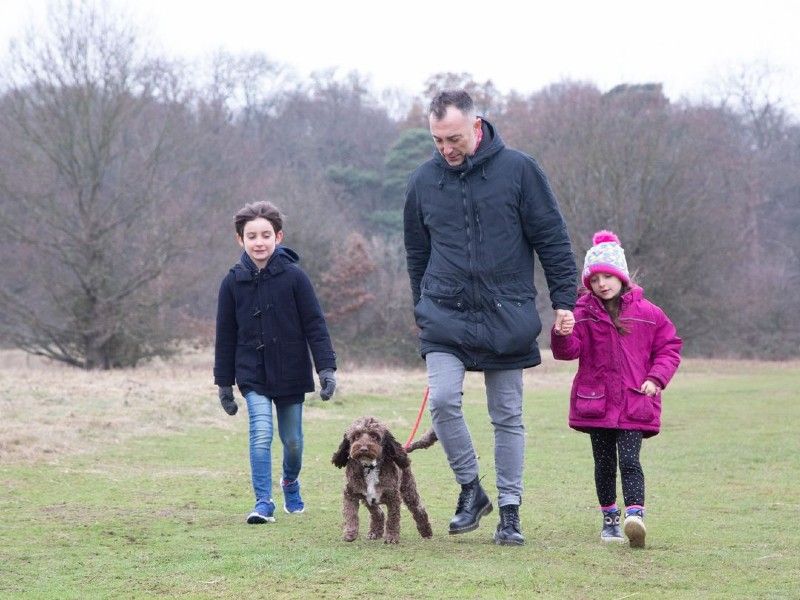
Getting a dog when you have children
Advice on everything from choosing a dog to helping them settle in with your family.

Owning a dog can make family life more active, fun and fulfilling. For your dog, joining your family can be the start of a fantastic adventure where they can live life to the full. Your children gain new skills and knowledge, which may build their confidence. It’s a great start to a lifetime of responsible pet ownership.
Of course, there’s lots to think about, from finding the right dog to organising training. Get things right, and your new pup will soon be a much-loved member of your family.
On this page, we’ll cover:
- Things to consider before adding a dog to your family
- Introducing a new dog to your children: six tips
- Helping your children feel more confident around dogs
- Next steps with your new pet
Things to consider before adding a dog to your family
The first step to success when adding a pup to your pack is considering what you could offer them and how you'll meet their needs. A happy and healthy dog is more likely to integrate well with your family.
Your family’s lifestyle
What kind of life do you have? Busy or quiet – active or laid back? You’ll need to find a dog that fits well with your family’s activities.
Think about how much time the family will have to devote to your dog’s needs each week. Your faithful friend will need:
- Daily exercise – with the amount depending on them
- Mental stimulation – playing games and learning new skills
- Basic training – learning the skills every dog needs
- Health care, such as regular grooming, and vet trips when needed
- If they’re a puppy – socialisation and time to learn toilet training.
These are important for a happy and healthy dog.
If you get a puppy, you’ll need to devote a lot of time to them in their first year. That's so you can housetrain them and make sure they're appropriately socialised.
Adult dogs vary in their ability to cope alone. Some are comfortable being left for a while. Others become stressed and anxious being alone even for a very short time. While some may get used to spending more time solo, others may never settle being left by themselves.
Healthy adult dogs shouldn’t be left by themselves for longer than they can cope with. All dogs have different and individual needs, and your vet should be able to give you advice for your dog.
With that in mind, you’ll need to think about who’ll be keeping them company during weekdays and at weekends. Can you organise day care for when the adults are out?
Another thing to consider is the number of visitors you host. Some dogs are very sociable and like making new human friends, others prefer to put their paws up in peace.
Your home and your dog
Each dog will need their own space indoors and access to the outside, with exact needs varying between individuals.
They’ll need somewhere to go – such as a doggy den – where they can rest undisturbed by adults and children. Could you provide this peaceful place for your pooch?
Some dogs need a large, secure garden while others would be happy with a smaller outside space. As long as they have regular access to the outside for exercise and toilet breaks, some dogs could live in a home without a garden.
It’s worth spending a few minutes considering your indoor – and any outdoor – space. What do you have, and how could you adapt it, to fit a dog’s needs?
The size and energy levels of the dog
If your children are primary school age or younger, would they feel comfortable with a large dog? A small-to-medium-sized pup could be a better fit. What about energy levels – would a bouncy dog suit your family or is a calmer pet a better bet?
Older children and adults will also have their preferences. If one family member loves large pooches and another is taken with terriers, it’s time to have a conversation to see if you can agree.
Considering the dog’s individual needs
Every dog is an individual with their own personality and needs.
Claims that certain breeds have specific characteristics, such as being good with children, need to be treated with caution – as that depends on the individual.
If you are adopting a dog, then you’ll need to pay attention to any special requirements mentioned on their profile by the rehoming organisation. They might need you to have previous experience of the breed or of specific dog behavioural issues. Are these something you – and your family – can support?
Introducing a new dog to your children: six tips
In their first few days at home, your dog will start to form bonds and build trust with the members of your family. With a bit of preparation, you can help ensure your pup’s first experiences are positive ones.
Tip one: chat with your children
If they’re old enough to understand, you could speak to your children about how to behave safely around dogs in the run-up to collecting them. Our top safety tips should help.
Tip two: rehoming centre visits
If you’re planning to adopt from a Dogs Trust rehoming centre, we’ll arrange for your family to meet the dog in a supervised visit. This does depend on the needs of the dog, but – if it’s possible – it’ll give your children an opportunity to meet their potential pet before a decision is made to adopt.
Tip three: closely supervise
Whenever your dog is with children (whether yours or someone else’s), they should always be closely supervised by an adult. The adult should be monitoring how the children and the dog are behaving. If either party becomes uncomfortable, they should intervene to bring the interaction to a safe end.

Tip four: take time to build the new relationship
When your new dog arrives, keep their initial introduction with your children short, positive and as calm as possible.
If the dog approaches your child for a sniff, then your child can let them do that. If the dog and the child are comfortable, then the child could give the dog a gentle stroke on the side.
Should the dog want more affection, they might stick around for another stroke, which is fine. If they move away at any point, then let them go without following.
Ensure an adult is present and closely supervising. They should watch for and respond to any signs that your dog, or child, feel uncomfortable and need space.
Tip five: give your dog some space
When your dog is eating their dinner, or playing with a toy by themselves, it’s important that they can do that undisturbed.
You could (gently) explain to your children that they wouldn't like it if someone took away their favourite toy or food and that dogs feel the same. It’s best to wait until the dog is ready to play.
Tip six: a place to escape
Humans need downtime and space to relax, and dogs are no different. You can support this by ensuring they have a comfortable space, such as a doggy den, which they can easily access. Ensure they’re not disturbed when they’re sleeping or resting there – by children or adults!
Next steps with your new pet
Some forward planning and careful introductions will help get your new dog off to a great start with your family. You can then sniff out our Dog School training classes or fetch some help and advice from our dedicated pages.
What to do if you’re expecting a baby
If you’re also expecting a new human addition to your family, our guides to owning a dog when you’re pregnant and preparing your dog for a new baby will help you to prepare your pooch.
Helping your children feel more confident around dogs
We offer workshops and online resources to help your family prepare and adjust to dog ownership, including:
- online workshops for families who have a dog (or are planning to get one): Dogs and Children: living happily together
- our workshops held in schools as well as education online resources.






